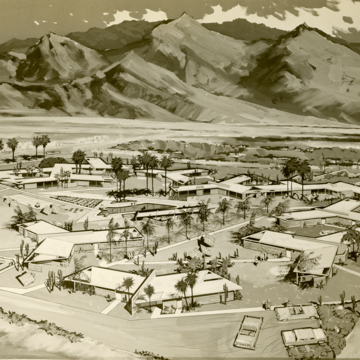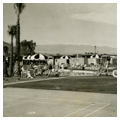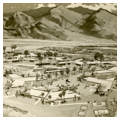You are here
L’Horizon Hotel and Spa
Designed by William F. Cody, L’Horizon Hotel in Palm Springs epitomizes the desert city’s signature California Modernist architecture. When it was built, the hotel was situated on a mostly undeveloped stretch of East Palm Canyon Drive, which is south and perpendicular of the main commercial thoroughfare of North Palm Canyon Drive. While the visual approach to the site from the street is obstructed by prominent hedges, the looming San Jacinto Mountain Range provides a dramatic backdrop. Once inside the property, the resort hotel consists of an intimate cluster of twenty-five units in seven original bungalows, arranged spaciously around a central swimming pool and a patchwork of small lawns and desert landscaping. The irregular composition of the buildings on the site are captured in architectural photographer Julius Shulman’s 1954 commission to document Cody’s design. The rugged mountains are visible from some vantage points, while other perspectives highlight dissonant structural lines along the property horizon.
Until 1940, Palm Springs had developed as a small resort town that catered largely to the Los Angeles elite, many of whom had ties to the film industry. After World War II, the area began to attract a broader public. Much like other suburban areas across the country, Palm Springs experienced an explosion of new construction in housing and, especially, resort housing. Indeed, Palm Springs set the pace for much of postwar suburban development in terms of the vision its architecture embodied. Architects such as Albert Frey, Richard Neutra, and John Lautner employed modern, affordable materials and minimalist yet sensitive designs to complement the unique colors and textures of the natural desert environment. Modernism as an aesthetic came to symbolize Americans’ desire to create living spaces that embodied the optimism and ethos of the postwar moment. Some of the most exquisite forms of midcentury modern architecture in the Palm Springs desert setting demonstrate the everyday functions of a growing community: designs for gas stations, banks, churches, libraries, and resort housing showcased the depth and ingenuity of the architects working within a fresh architectural vocabulary.
L’Horizon Hotel is notable both for its exemplary midcentury modern aesthetic and innovative design features, as well as its connection to Palm Springs’s historic and cultural heritage. Cody designed L’Horizon for producer Jack Wrather and actress Bonita Granville, prominent figures in the Hollywood film industry. Wrather moved to Hollywood after operating his father’s Texas oil refining company and later serving in the U.S. Marine Corps during World War II. He established a film production company in the late 1940s and began producing films and later television; he is perhaps best remembered as the producer of the television series Lassie and The Lone Ranger. In 1947 Wrather married Granville, who had appeared in numerous films during the 1930s and 1940s, and received a nomination for an Academy Award for her role as supporting actress in These Three (1936). Wrather and Granville hired Cody in 1952 to design a resort complex where they could host their family and friends in the nearby resort town of Palm Springs. Wrather would later enter a venture with Walt Disney by funding the construction of the Disneyland Hotel. Famous guests to L’Horizon over the years included Marilyn Monroe, Betty Grable, and U.S. presidents Richard Nixon and Ronald Reagan.
L’Horizon Hotel is representative of midcentury modern resort architecture in a number of ways. The emphasis on the swimming pool as the social center of the resort and the increasing isolation of individual bungalow units mirrored other motel and resort designs of the postwar era. Cody would later expand on this model through his early contributions to resort housing developments around golf course fairways. At L’Horizon, the individual units range from studios and suites to a three-bedroom, two-bath house. The composition of individual courtyards and private entries intersect gracefully with the more expansive commons of the pool and grassy areas. Cody designed the units with floor-to-ceiling glass walls, and bathrooms with sunken showers leading to private gardens outdoors. Cody incorporated slump stone walls in portions of the bungalows and exterior walls, replicating a material he had earlier used for the design of his own Palm Springs residence. The flat and low-slant roofs and graceful, wide eaves of the bungalows echoed the work other prominent midcentury modern architects, though Cody possessed a deft ability to create the illusion of ultra-thin floating rooflines through delicate precision.
The layout of the cottages demonstrated Cody’s ability to challenge the established tenets of modernism while bringing warmth to the modern aesthetic. Instead of the rectilinear lines of his contemporaries, Cody’s used an oblique grid as staging, as well as acute and splayed angles in trellises and walls. The asymmetry of the ensemble brought a sense of playfulness to the project. These formal irregularities carried forward his use of slanted windows and diagonal lines in his earlier organic wood-and-stone design for the Del Marcos Hotel (1946). The striking result of Cody’s use of lines and angles in L’Horizon has been expertly illustrated both in Cody’s architectural rendering and Shulman's visual documentation.
Cody had graduated from University of Southern California’s School of Architecture in 1942. During his studies, Cody worked as a draftsman for Cliff May, known for his development of the California ranch house. This professional experience influenced Cody’s later work, which featured a strong relationship between interior and exterior spaces as well as an emphasis on comfortable designs for living. Cody and his family moved to Palm Springs in 1946 for health reasons. It was there that Cody developed his unique style of desert modern architecture that highlighted his sensitivity to the geography and climate, and his masterful use of thin, clean lines. Architectural historian Alan Hess has stated that Cody was perhaps the most individual among the modern architects working in Palm Springs at midcentury. Hess also refers to Cody’s work as remarkably inventive and extremely disciplined—the “architecture of precision.” This craftsmanship is showcased in Cody’s vision and execution of L’Horizon.
While much of the architectural integrity of the hotel has remained intact, L’Horizon Hotel experienced neglect in recent decades and has lost its exclusive clientele. In an effort to bring the resort back to life, architectural designer and developer Steve Hermann recently purchased the hotel and spent two years and $5 million on renovations. Hermann’s improvements include a mix of new and vintage furnishings. L’Horizon Resort and Spa reopened in June 2015.
References
Cody, William F. Papers (1924-1975). California Polytechnic State University, San Louis Obispo.
Cody, William F. Papers 2 (1918-1980). California Polytechnic State University, San Louis Obispo.
Gorst, Jake, and David Shearer . Desert Utopia: Mid-Century Architecture in Palm Springs. DVD. Denver, CO: Design Onscreen, 2011.
Julius Shulman Photography Archive, 1936-1997. Series IV. Job numbers, 1934-2009. Getty Research Institute, Los Angeles, California.
Palm Springs Preservation Foundation. The Architecture of William F. Cody: A Desert Retrospective. Palm Springs Preservation Foundation, 2004.
Shulman, Julius, Michael Stern, Alan Hess, and David Martin. Julius Shulman: Desert Modern. DVD. Palm Springs, CA: Palm Springs Art Museum, 2008.
Shulman, Julius. Job 1757: L’Horizon Hotel (Palm Springs, Calif.), 1954. Getty Research Institute, Los Angeles, California.
Wrather Papers, Jack and Bonita Granville (1890-1990). Special Collections Department, William H. Hannon Library, Loyola Marymount University.
Writing Credits
If SAH Archipedia has been useful to you, please consider supporting it.
SAH Archipedia tells the story of the United States through its buildings, landscapes, and cities. This freely available resource empowers the public with authoritative knowledge that deepens their understanding and appreciation of the built environment. But the Society of Architectural Historians, which created SAH Archipedia with University of Virginia Press, needs your support to maintain the high-caliber research, writing, photography, cartography, editing, design, and programming that make SAH Archipedia a trusted online resource available to all who value the history of place, heritage tourism, and learning.




